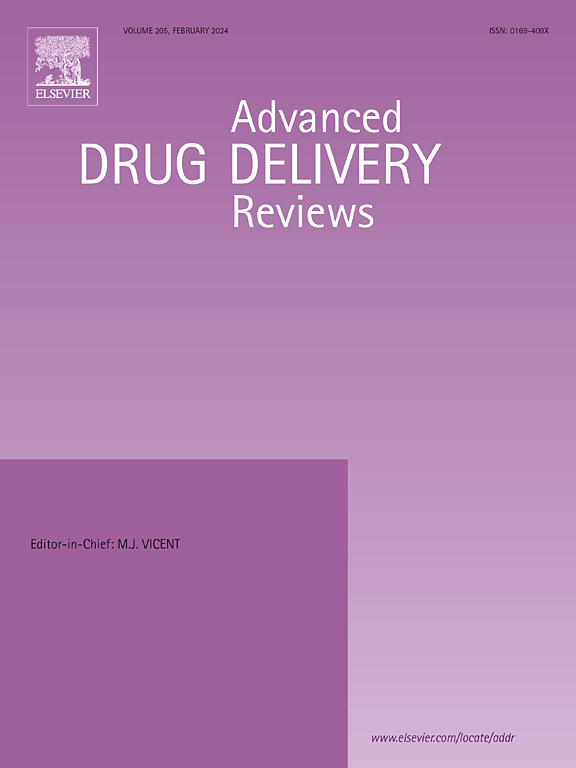Enhancing the persistence of engineered biotherapeutics in the gut: Adhesion, glycan metabolism, and environmental resistance
IF 17.6
1区 医学
Q1 PHARMACOLOGY & PHARMACY
引用次数: 0
Abstract
Engineered live biotherapeutic products (eLBPs) are receiving increasing attention as next-generation therapeutics to treat a variety of diseases with high specificity and effectiveness. Despite their potential, eLBPs face challenges, such as limited colonization, competition with native microbiota, nutrient depletion, and susceptibility to gastrointestinal stresses, which ultimately reduce their persistence in the gut and hinder their therapeutic efficacy. This review examines the key strategies to enhance the persistence and activity of eLBPs in the gut environment. First, methods to strengthen the adhesion capacity of eLBPs are discussed, including genetic engineering to express adhesins and chemical surface modifications to improve their binding to mucus and epithelial cells. Second, strategies to improve the ability of eLBPs to efficiently use mucin-derived sugars, which are continuously secreted by intestinal epithelial cells, were highlighted. These strategies involve the introduction and optimization of glycan-degrading enzymes and metabolic pathways for key mucin sugars, such as N-acetylglucosamine, galactose, and sialic acid, to support sustained energy production and enhance gut colonization. Third, strategies to improve the resistance of eLBPs against environmental stress are discussed, including genetic modifications to stabilize cell membranes, enhancement of ion pump activity, overexpression of stress-response proteins, and encapsulation techniques to provide protection. The implementation of these strategies can address challenges related to gut colonization by eLBPs, thereby enhancing their metabolic activity and enabling sustained and efficient secretion of therapeutic molecules. This review offers a comprehensive framework for developing and optimizing eLBPs, paving the way for their successful clinical application with enhanced effectiveness in treating gastrointestinal and systemic diseases.


增强工程生物治疗药物在肠道中的持久性:粘附,聚糖代谢和环境抗性
工程活生物治疗产品(elbp)作为具有高特异性和有效性的新一代治疗药物,正受到越来越多的关注。尽管具有潜力,但elbp面临着挑战,如有限的定植,与本地微生物群的竞争,营养物质的消耗以及对胃肠道应激的易感性,这些最终降低了它们在肠道中的持久性并阻碍了它们的治疗效果。本文综述了增强elbp在肠道环境中的持久性和活性的关键策略。首先,讨论了增强elbp粘附能力的方法,包括通过基因工程表达粘附素和化学表面修饰来提高其与黏液和上皮细胞的结合能力。其次,重点介绍了提高elbp有效利用肠上皮细胞持续分泌的黏液衍生糖的能力的策略。这些策略包括引入和优化聚糖降解酶和关键粘蛋白糖(如n-乙酰氨基葡萄糖、半乳糖和唾液酸)的代谢途径,以支持持续的能量生产和增强肠道定植。第三,讨论了提高elbp对环境胁迫抗性的策略,包括稳定细胞膜的遗传修饰,增强离子泵活性,应激反应蛋白的过表达以及提供保护的封装技术。这些策略的实施可以解决与elbp肠道定植相关的挑战,从而增强其代谢活性,并使治疗分子能够持续有效地分泌。本综述为开发和优化elbp提供了一个全面的框架,为其成功的临床应用铺平了道路,并提高了治疗胃肠道和全身性疾病的有效性。
本文章由计算机程序翻译,如有差异,请以英文原文为准。
求助全文
约1分钟内获得全文
求助全文
来源期刊
CiteScore
28.10
自引率
5.00%
发文量
294
审稿时长
15.1 weeks
期刊介绍:
The aim of the Journal is to provide a forum for the critical analysis of advanced drug and gene delivery systems and their applications in human and veterinary medicine. The Journal has a broad scope, covering the key issues for effective drug and gene delivery, from administration to site-specific delivery.
In general, the Journal publishes review articles in a Theme Issue format. Each Theme Issue provides a comprehensive and critical examination of current and emerging research on the design and development of advanced drug and gene delivery systems and their application to experimental and clinical therapeutics. The goal is to illustrate the pivotal role of a multidisciplinary approach to modern drug delivery, encompassing the application of sound biological and physicochemical principles to the engineering of drug delivery systems to meet the therapeutic need at hand. Importantly the Editorial Team of ADDR asks that the authors effectively window the extensive volume of literature, pick the important contributions and explain their importance, produce a forward looking identification of the challenges facing the field and produce a Conclusions section with expert recommendations to address the issues.

 求助内容:
求助内容: 应助结果提醒方式:
应助结果提醒方式:


